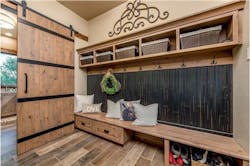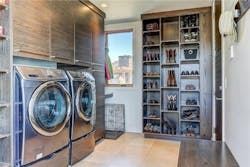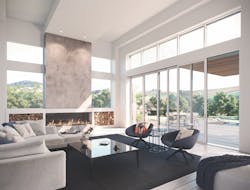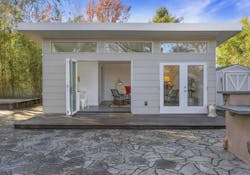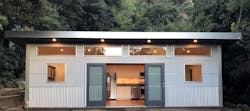As the pandemic continues, homeowners are encouraged to spend more time indoors—so get ready for more remodel requests.
Here's five projects that loom large on many wish lists and expert advice on executing them correctly. Some are variations of existing trends, but all are expected to add function, value, and joy to houses inside and out.
#1 Better outfitted mudrooms
Help homeowners avoid frantic searches for keys, backpacks, gloves, hats, lost socks, and more by constructing a mudroom that’s dedicated to different needs.
Homeowners who build from scratch are increasingly purchasing a plan with a mudroom, also called an all-purpose drop zone, says Laurel Verazza Gecek of The Plan Collection, a design company that offers house plans online. For those homeowners who call on you to renovate, suggest they convert an underutilized space, such as part of a garage or laundry room.
Additional functions in high demand are drop-off areas for package and grocery-store deliveries; pet washing stations with an oversized sink or shower pan and storage; specified storage for each family member; laundry equipment area complemented with shelves, a counter for folding, and a sink; a central charging station for everyone’s tech tools; and something fun such as a boot dryer. Go with a waterproof, easy-to-clean luxury vinyl tile floor and install enough recessed LED lights.
Photo: The Plan Collection
#2 More specialized outdoor “rooms”
Creating the equivalent of rooms in a backyard started pre-pandemic, but after sheltering indoors, more homeowners asked their remodeling professionals to build different spaces to suit favorite interests.
A small backyard? No problem. Advise clients to narrow their list. Landscape architect Ryan Kettelkamp of Chicago-area Kettelkamp & Kettelkamp found more clients wanted an outdoor kitchen this past season. It didn’t have to rival their indoor one, but worked well with a grill, water source, and the newest bell and whistle: a pizza oven.
Others, he expects, will want a firepit or fireplace and lawn or terrace to set out a large screen and chairs to watch movies, and an edible garden, after avoiding supermarket runs last year. Raised rectangular wood planters, aluminum troughs, and big frost-hardy containers help gardeners also avoid bending and weeding.
By erecting some trellises, homeowners can also plant up and conserve land. Kettlekamp says to be sure there’s a nearby water source and suggest fencing that goes deep and high to prevent animals from sharing produce.
For hardscape, Kettelkamp recommends classic bluestone installed in a random contemporary pattern of 12 by 24 inch or 18 by 36 inch stones.
So clients can use their rooms even as weather gets nippy, suggest they purchase a heater, similar to what restaurants use to warm outdoor diners. The 2021 Houzz & Home Study, also found an uptick in fixing up beds, borders, and lawns, and upgrading decks, porches, or balconies.
Photo: courtesy Marvin
#3 More window, door, and wall glazing to savor nature
The trend of homeowners wanting to feel as though they’re outdoors even when they can’t be is expected to continue as nature is considered a boon to wellness.
Be ready to change out windows and doors, and sometimes an entire wall to fit larger glass options. Some like garage-style glass doors that roll up for an edgier look, designers say. In kitchens, Chicago designer Mick De Giulio of de Giulio Kitchen Design installs windows as high as possible (depending on ceiling height) and down to the top of a countertop (36 inches), but if there’s no countertop, close to the floor.
“Any way to gain glass and a view is preferred,” he says. De Giulio also likes the availability from manufacturers of windows and doors with less framework for a thinner profile. An example is Marvin’s Modern window line that achieves a narrow modern aesthetic, says Christine Marvin, vice president of design. The line is extremely durable and energy efficient, she adds.
Photo: Studio Shed
#4 More flexible home offices
Another pandemic lesson was the importance of having a place for adults to conduct office work and children to do homework.
In fact, searches for home offices were up 108%, according to the 2021 Houzz Emerging Home Design Trends Report. And even as many return to the workplace and school, coronavirus numbers are expected to make adaptable areas popular.
Help your clients find a room or area that will work, depending on the desired level of privacy, light, and quiet, but make it work for other uses as well.
Hartford, Conn.-based designer Sharon McCormick suggests asking clients these questions to guide your design:
- Do you need a door?
- Do you want a space with a window for natural light?
- Are you willing to share space?
- Do you have an extra room to use, a big walk-in closet, a large landing, or attic or basement?
- What accessories do you need—a work surface with built-in keyboard, ergonomic chair, a guest chair, good lighting, file cabinet, outlets?
Two new trends to be aware of are installing a screen on a wall and using a standing desk, says McCormick.
One caveat: Chicago designer Tom Segal of Kaufman Segal cautions about having a guest bedroom double as workspace. “It’s a challenge to keep changing it from one use to the other and putting away papers,” he says.
Photo: Studio Shed
#5. Accessory dwelling units
After constructing and remodeling your share of tiny houses and he/she sheds, get ready for more clients requesting an accessory dwelling unit (ADU).
These structures generally are detached from the main house and range in size between 500 and 800 square feet but as large as 1,200 square feet, says Caitlin Bigelow, an ADU advocate who runs Maxable, an educational resource on ADUs.
Increased approval from planning and building departments has boosted ADU popularity, especially as a housing solution for homeowners needing space for returning grown children, for renters to help meet the shortage of affordable housing, and older parents wanting to age in place privately in what’s often called a “granny flat.”
Be sure to check local codes on size, setbacks, and other requirements, and that the unit has good natural light, insulation, key appliances, and features that reflect universal design principles so it’s accessible for all, notes Bigelow.
She also recommends installing wide enough doorways for a wheelchair and removing thresholds between areas, for example. “You want to plan smart from the start,” she says. Also consider saving time and economies of scale by starting with a prefab model such as one of Studio Shed’s larger “Summit/ADU” units, available in custom configurations.
